ITIL Business Relationship Management Process in IT Service Management
VerifiedAdded on 2022/12/23
|9
|1997
|28
Report
AI Summary
This report delves into the ITIL Business Relationship Management (BRM) process, examining its purpose, objectives, and activities within the ITIL framework. It highlights the role of the Business Relationship Manager in maintaining customer relationships, identifying service requirements, and ensuring customer satisfaction. The report explores the influence of BRM on various ITIL lifecycle processes, contrasting it with Service Level Management. A case study on HP's implementation of BRM illustrates the practical application and benefits of the process. The conclusion emphasizes the importance of BRM in defining, understanding, and supporting inter-business activities related to business networking, and its role as a crucial link between the business and the service provider. The provided document is an assignment solution contributed by a student and published on Desklib, a platform offering AI-powered study tools for students.
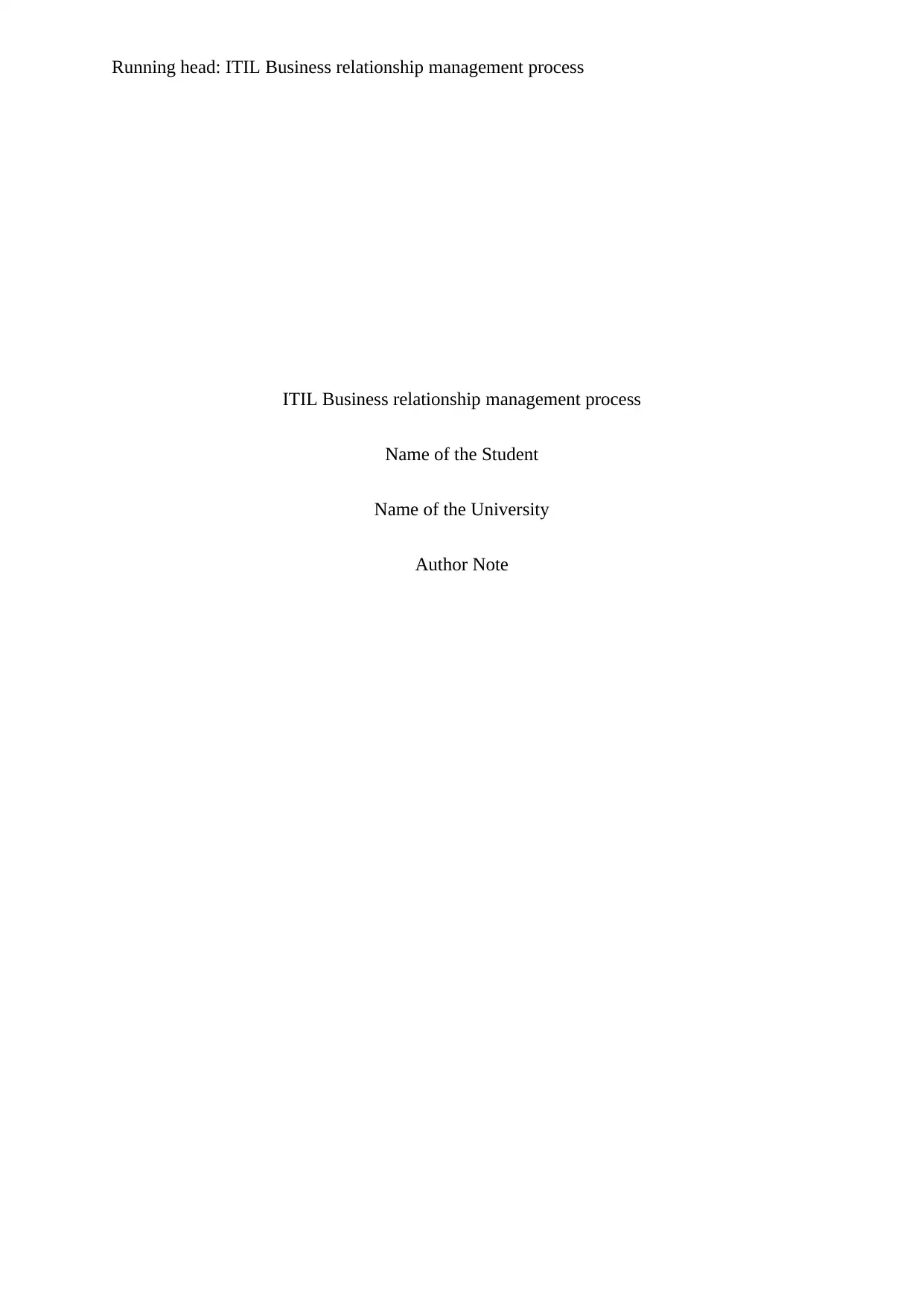
Running head: ITIL Business relationship management process
ITIL Business relationship management process
Name of the Student
Name of the University
Author Note
ITIL Business relationship management process
Name of the Student
Name of the University
Author Note
Paraphrase This Document
Need a fresh take? Get an instant paraphrase of this document with our AI Paraphraser
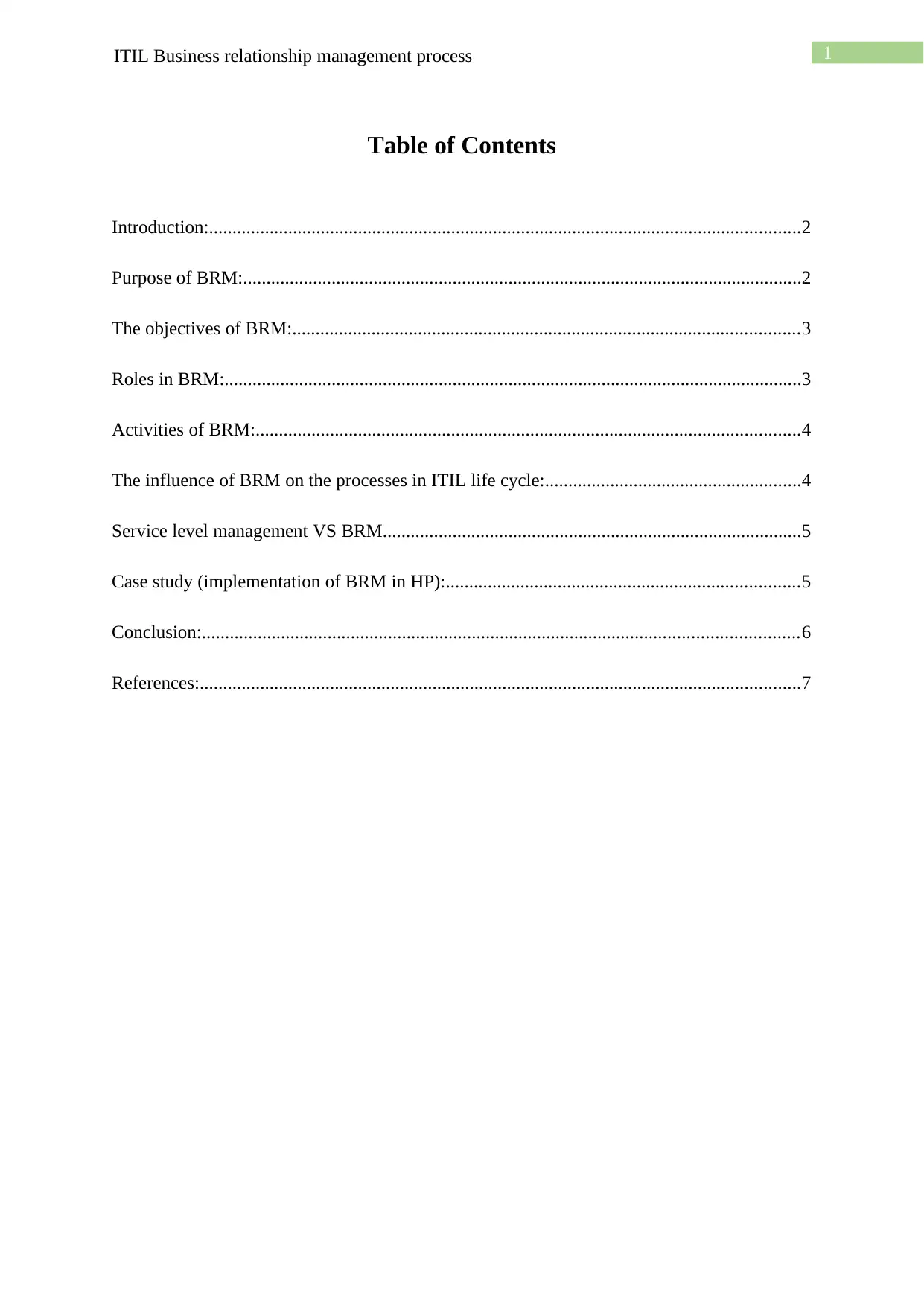
ITIL Business relationship management process 1
Table of Contents
Introduction:...............................................................................................................................2
Purpose of BRM:........................................................................................................................2
The objectives of BRM:.............................................................................................................3
Roles in BRM:............................................................................................................................3
Activities of BRM:.....................................................................................................................4
The influence of BRM on the processes in ITIL life cycle:.......................................................4
Service level management VS BRM..........................................................................................5
Case study (implementation of BRM in HP):............................................................................5
Conclusion:................................................................................................................................6
References:.................................................................................................................................7
Table of Contents
Introduction:...............................................................................................................................2
Purpose of BRM:........................................................................................................................2
The objectives of BRM:.............................................................................................................3
Roles in BRM:............................................................................................................................3
Activities of BRM:.....................................................................................................................4
The influence of BRM on the processes in ITIL life cycle:.......................................................4
Service level management VS BRM..........................................................................................5
Case study (implementation of BRM in HP):............................................................................5
Conclusion:................................................................................................................................6
References:.................................................................................................................................7
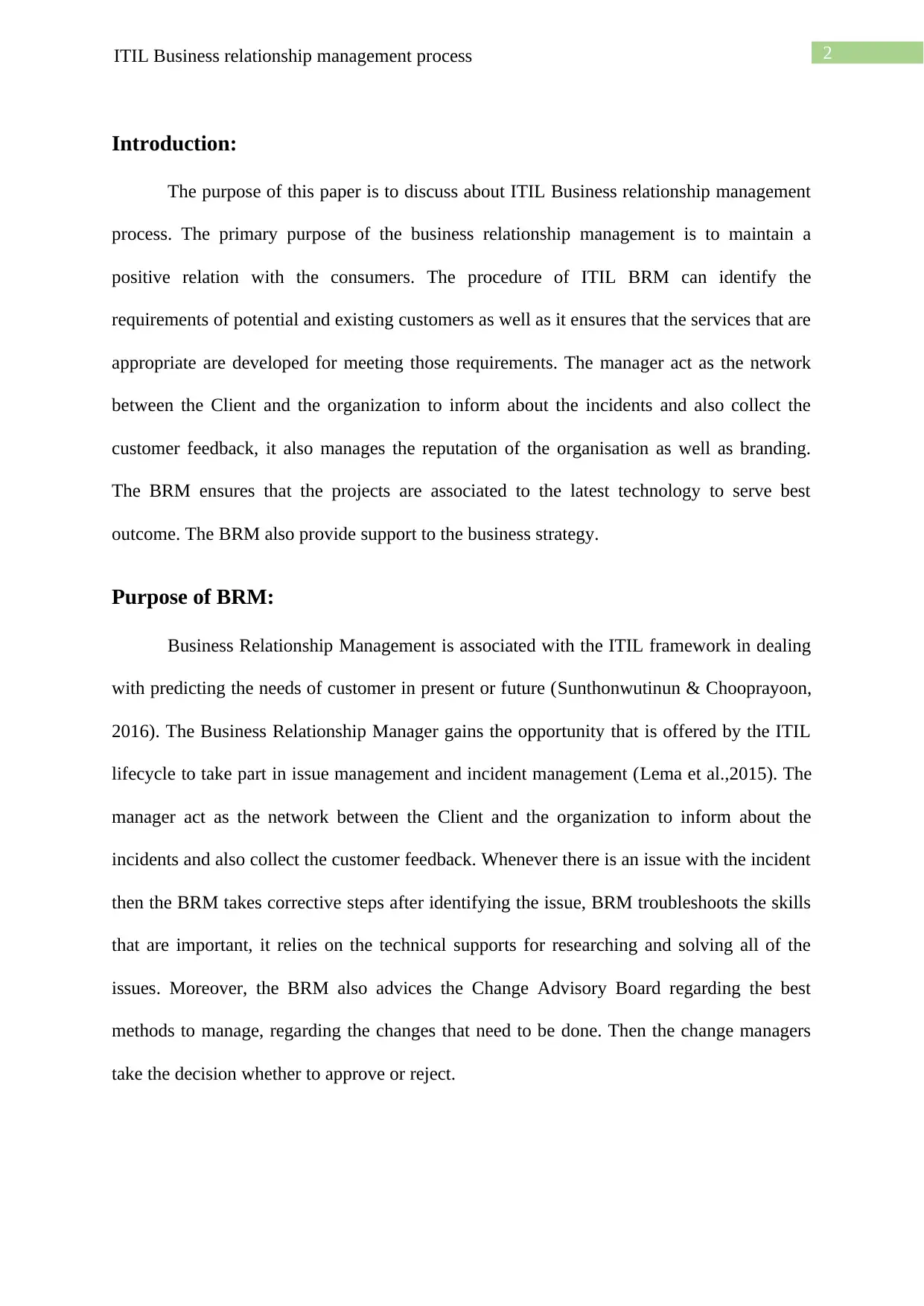
2ITIL Business relationship management process
Introduction:
The purpose of this paper is to discuss about ITIL Business relationship management
process. The primary purpose of the business relationship management is to maintain a
positive relation with the consumers. The procedure of ITIL BRM can identify the
requirements of potential and existing customers as well as it ensures that the services that are
appropriate are developed for meeting those requirements. The manager act as the network
between the Client and the organization to inform about the incidents and also collect the
customer feedback, it also manages the reputation of the organisation as well as branding.
The BRM ensures that the projects are associated to the latest technology to serve best
outcome. The BRM also provide support to the business strategy.
Purpose of BRM:
Business Relationship Management is associated with the ITIL framework in dealing
with predicting the needs of customer in present or future (Sunthonwutinun & Chooprayoon,
2016). The Business Relationship Manager gains the opportunity that is offered by the ITIL
lifecycle to take part in issue management and incident management (Lema et al.,2015). The
manager act as the network between the Client and the organization to inform about the
incidents and also collect the customer feedback. Whenever there is an issue with the incident
then the BRM takes corrective steps after identifying the issue, BRM troubleshoots the skills
that are important, it relies on the technical supports for researching and solving all of the
issues. Moreover, the BRM also advices the Change Advisory Board regarding the best
methods to manage, regarding the changes that need to be done. Then the change managers
take the decision whether to approve or reject.
Introduction:
The purpose of this paper is to discuss about ITIL Business relationship management
process. The primary purpose of the business relationship management is to maintain a
positive relation with the consumers. The procedure of ITIL BRM can identify the
requirements of potential and existing customers as well as it ensures that the services that are
appropriate are developed for meeting those requirements. The manager act as the network
between the Client and the organization to inform about the incidents and also collect the
customer feedback, it also manages the reputation of the organisation as well as branding.
The BRM ensures that the projects are associated to the latest technology to serve best
outcome. The BRM also provide support to the business strategy.
Purpose of BRM:
Business Relationship Management is associated with the ITIL framework in dealing
with predicting the needs of customer in present or future (Sunthonwutinun & Chooprayoon,
2016). The Business Relationship Manager gains the opportunity that is offered by the ITIL
lifecycle to take part in issue management and incident management (Lema et al.,2015). The
manager act as the network between the Client and the organization to inform about the
incidents and also collect the customer feedback. Whenever there is an issue with the incident
then the BRM takes corrective steps after identifying the issue, BRM troubleshoots the skills
that are important, it relies on the technical supports for researching and solving all of the
issues. Moreover, the BRM also advices the Change Advisory Board regarding the best
methods to manage, regarding the changes that need to be done. Then the change managers
take the decision whether to approve or reject.
⊘ This is a preview!⊘
Do you want full access?
Subscribe today to unlock all pages.

Trusted by 1+ million students worldwide
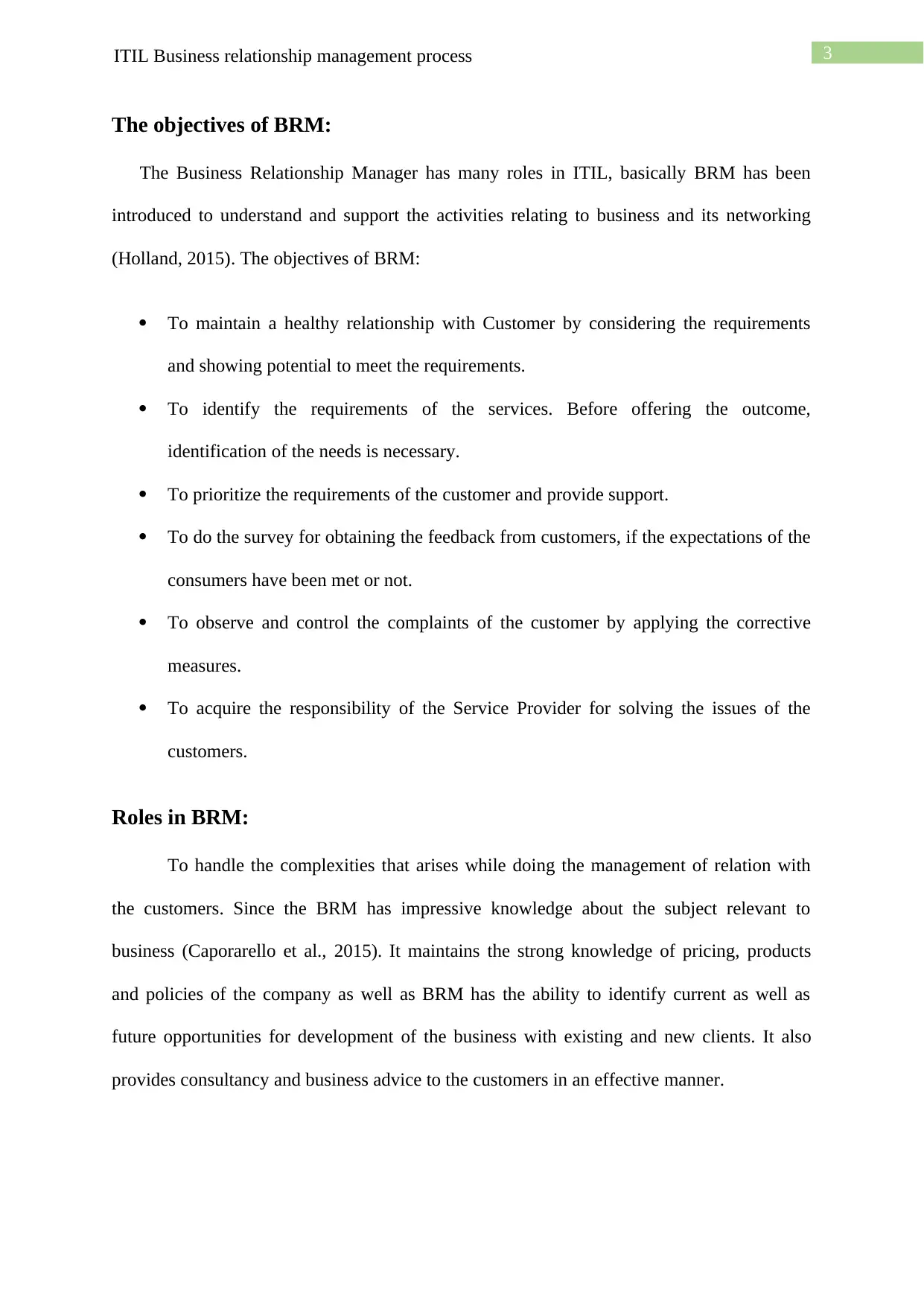
3ITIL Business relationship management process
The objectives of BRM:
The Business Relationship Manager has many roles in ITIL, basically BRM has been
introduced to understand and support the activities relating to business and its networking
(Holland, 2015). The objectives of BRM:
To maintain a healthy relationship with Customer by considering the requirements
and showing potential to meet the requirements.
To identify the requirements of the services. Before offering the outcome,
identification of the needs is necessary.
To prioritize the requirements of the customer and provide support.
To do the survey for obtaining the feedback from customers, if the expectations of the
consumers have been met or not.
To observe and control the complaints of the customer by applying the corrective
measures.
To acquire the responsibility of the Service Provider for solving the issues of the
customers.
Roles in BRM:
To handle the complexities that arises while doing the management of relation with
the customers. Since the BRM has impressive knowledge about the subject relevant to
business (Caporarello et al., 2015). It maintains the strong knowledge of pricing, products
and policies of the company as well as BRM has the ability to identify current as well as
future opportunities for development of the business with existing and new clients. It also
provides consultancy and business advice to the customers in an effective manner.
The objectives of BRM:
The Business Relationship Manager has many roles in ITIL, basically BRM has been
introduced to understand and support the activities relating to business and its networking
(Holland, 2015). The objectives of BRM:
To maintain a healthy relationship with Customer by considering the requirements
and showing potential to meet the requirements.
To identify the requirements of the services. Before offering the outcome,
identification of the needs is necessary.
To prioritize the requirements of the customer and provide support.
To do the survey for obtaining the feedback from customers, if the expectations of the
consumers have been met or not.
To observe and control the complaints of the customer by applying the corrective
measures.
To acquire the responsibility of the Service Provider for solving the issues of the
customers.
Roles in BRM:
To handle the complexities that arises while doing the management of relation with
the customers. Since the BRM has impressive knowledge about the subject relevant to
business (Caporarello et al., 2015). It maintains the strong knowledge of pricing, products
and policies of the company as well as BRM has the ability to identify current as well as
future opportunities for development of the business with existing and new clients. It also
provides consultancy and business advice to the customers in an effective manner.
Paraphrase This Document
Need a fresh take? Get an instant paraphrase of this document with our AI Paraphraser
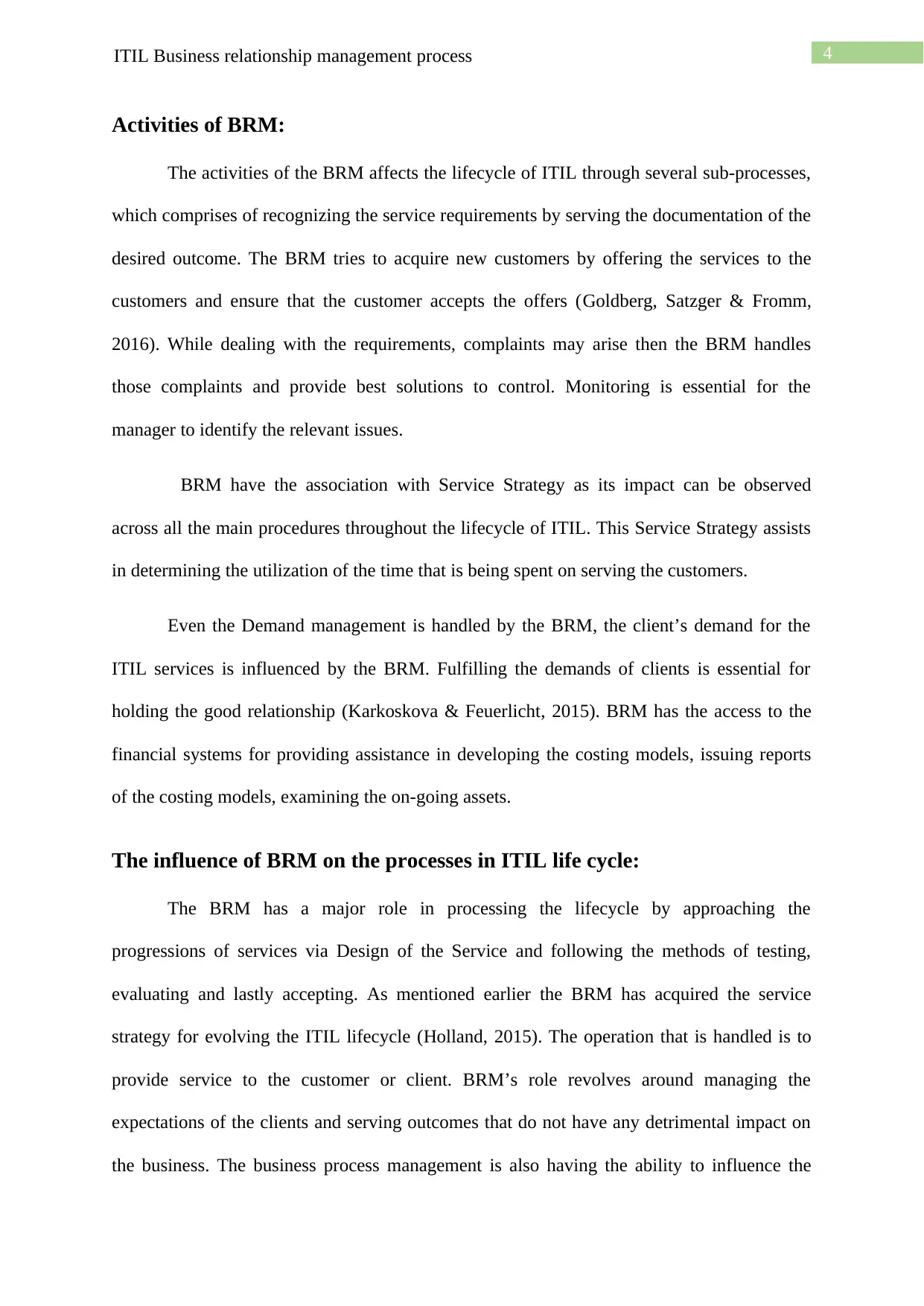
4ITIL Business relationship management process
Activities of BRM:
The activities of the BRM affects the lifecycle of ITIL through several sub-processes,
which comprises of recognizing the service requirements by serving the documentation of the
desired outcome. The BRM tries to acquire new customers by offering the services to the
customers and ensure that the customer accepts the offers (Goldberg, Satzger & Fromm,
2016). While dealing with the requirements, complaints may arise then the BRM handles
those complaints and provide best solutions to control. Monitoring is essential for the
manager to identify the relevant issues.
BRM have the association with Service Strategy as its impact can be observed
across all the main procedures throughout the lifecycle of ITIL. This Service Strategy assists
in determining the utilization of the time that is being spent on serving the customers.
Even the Demand management is handled by the BRM, the client’s demand for the
ITIL services is influenced by the BRM. Fulfilling the demands of clients is essential for
holding the good relationship (Karkoskova & Feuerlicht, 2015). BRM has the access to the
financial systems for providing assistance in developing the costing models, issuing reports
of the costing models, examining the on-going assets.
The influence of BRM on the processes in ITIL life cycle:
The BRM has a major role in processing the lifecycle by approaching the
progressions of services via Design of the Service and following the methods of testing,
evaluating and lastly accepting. As mentioned earlier the BRM has acquired the service
strategy for evolving the ITIL lifecycle (Holland, 2015). The operation that is handled is to
provide service to the customer or client. BRM’s role revolves around managing the
expectations of the clients and serving outcomes that do not have any detrimental impact on
the business. The business process management is also having the ability to influence the
Activities of BRM:
The activities of the BRM affects the lifecycle of ITIL through several sub-processes,
which comprises of recognizing the service requirements by serving the documentation of the
desired outcome. The BRM tries to acquire new customers by offering the services to the
customers and ensure that the customer accepts the offers (Goldberg, Satzger & Fromm,
2016). While dealing with the requirements, complaints may arise then the BRM handles
those complaints and provide best solutions to control. Monitoring is essential for the
manager to identify the relevant issues.
BRM have the association with Service Strategy as its impact can be observed
across all the main procedures throughout the lifecycle of ITIL. This Service Strategy assists
in determining the utilization of the time that is being spent on serving the customers.
Even the Demand management is handled by the BRM, the client’s demand for the
ITIL services is influenced by the BRM. Fulfilling the demands of clients is essential for
holding the good relationship (Karkoskova & Feuerlicht, 2015). BRM has the access to the
financial systems for providing assistance in developing the costing models, issuing reports
of the costing models, examining the on-going assets.
The influence of BRM on the processes in ITIL life cycle:
The BRM has a major role in processing the lifecycle by approaching the
progressions of services via Design of the Service and following the methods of testing,
evaluating and lastly accepting. As mentioned earlier the BRM has acquired the service
strategy for evolving the ITIL lifecycle (Holland, 2015). The operation that is handled is to
provide service to the customer or client. BRM’s role revolves around managing the
expectations of the clients and serving outcomes that do not have any detrimental impact on
the business. The business process management is also having the ability to influence the
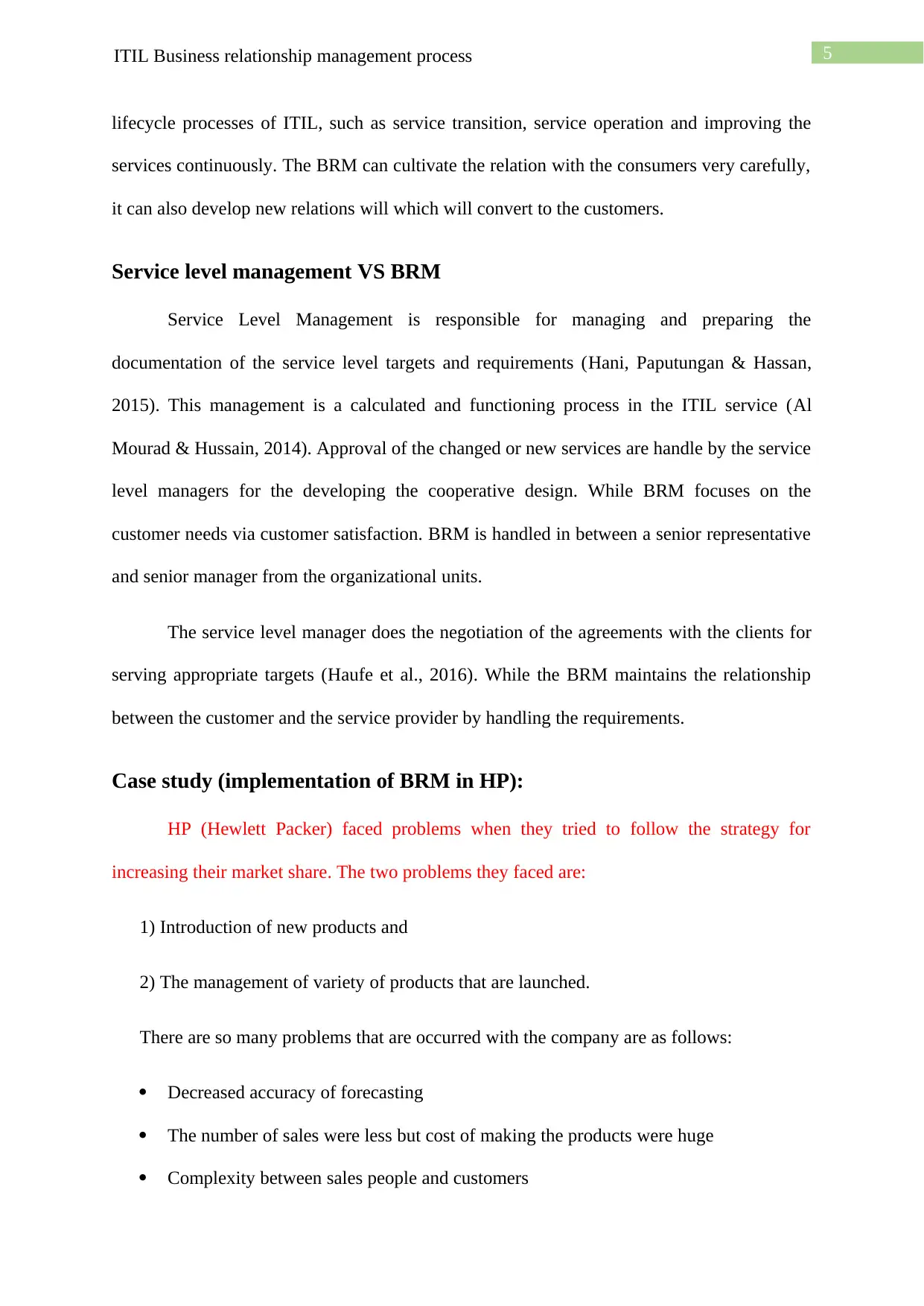
5ITIL Business relationship management process
lifecycle processes of ITIL, such as service transition, service operation and improving the
services continuously. The BRM can cultivate the relation with the consumers very carefully,
it can also develop new relations will which will convert to the customers.
Service level management VS BRM
Service Level Management is responsible for managing and preparing the
documentation of the service level targets and requirements (Hani, Paputungan & Hassan,
2015). This management is a calculated and functioning process in the ITIL service (Al
Mourad & Hussain, 2014). Approval of the changed or new services are handle by the service
level managers for the developing the cooperative design. While BRM focuses on the
customer needs via customer satisfaction. BRM is handled in between a senior representative
and senior manager from the organizational units.
The service level manager does the negotiation of the agreements with the clients for
serving appropriate targets (Haufe et al., 2016). While the BRM maintains the relationship
between the customer and the service provider by handling the requirements.
Case study (implementation of BRM in HP):
HP (Hewlett Packer) faced problems when they tried to follow the strategy for
increasing their market share. The two problems they faced are:
1) Introduction of new products and
2) The management of variety of products that are launched.
There are so many problems that are occurred with the company are as follows:
Decreased accuracy of forecasting
The number of sales were less but cost of making the products were huge
Complexity between sales people and customers
lifecycle processes of ITIL, such as service transition, service operation and improving the
services continuously. The BRM can cultivate the relation with the consumers very carefully,
it can also develop new relations will which will convert to the customers.
Service level management VS BRM
Service Level Management is responsible for managing and preparing the
documentation of the service level targets and requirements (Hani, Paputungan & Hassan,
2015). This management is a calculated and functioning process in the ITIL service (Al
Mourad & Hussain, 2014). Approval of the changed or new services are handle by the service
level managers for the developing the cooperative design. While BRM focuses on the
customer needs via customer satisfaction. BRM is handled in between a senior representative
and senior manager from the organizational units.
The service level manager does the negotiation of the agreements with the clients for
serving appropriate targets (Haufe et al., 2016). While the BRM maintains the relationship
between the customer and the service provider by handling the requirements.
Case study (implementation of BRM in HP):
HP (Hewlett Packer) faced problems when they tried to follow the strategy for
increasing their market share. The two problems they faced are:
1) Introduction of new products and
2) The management of variety of products that are launched.
There are so many problems that are occurred with the company are as follows:
Decreased accuracy of forecasting
The number of sales were less but cost of making the products were huge
Complexity between sales people and customers
⊘ This is a preview!⊘
Do you want full access?
Subscribe today to unlock all pages.

Trusted by 1+ million students worldwide
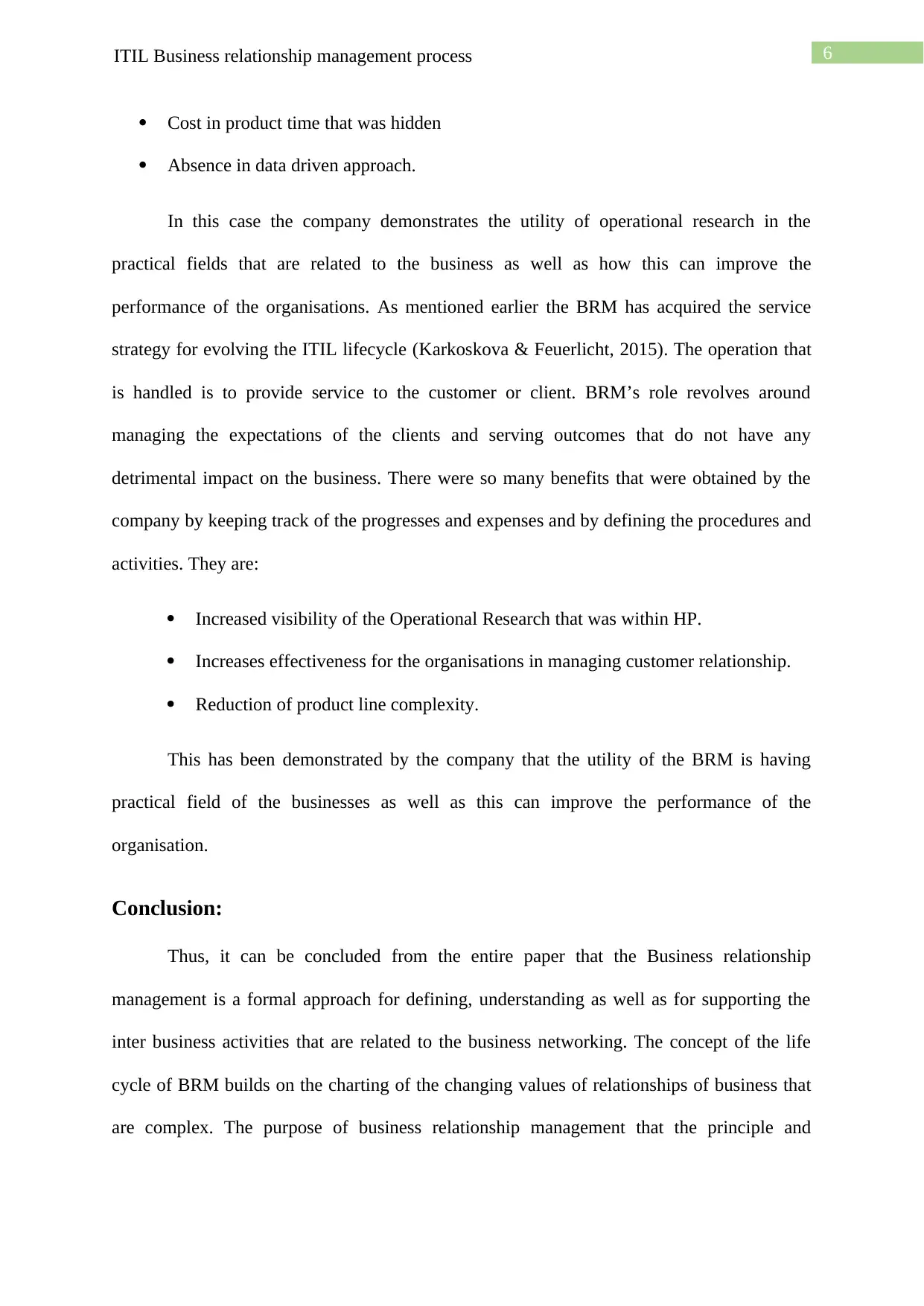
6ITIL Business relationship management process
Cost in product time that was hidden
Absence in data driven approach.
In this case the company demonstrates the utility of operational research in the
practical fields that are related to the business as well as how this can improve the
performance of the organisations. As mentioned earlier the BRM has acquired the service
strategy for evolving the ITIL lifecycle (Karkoskova & Feuerlicht, 2015). The operation that
is handled is to provide service to the customer or client. BRM’s role revolves around
managing the expectations of the clients and serving outcomes that do not have any
detrimental impact on the business. There were so many benefits that were obtained by the
company by keeping track of the progresses and expenses and by defining the procedures and
activities. They are:
Increased visibility of the Operational Research that was within HP.
Increases effectiveness for the organisations in managing customer relationship.
Reduction of product line complexity.
This has been demonstrated by the company that the utility of the BRM is having
practical field of the businesses as well as this can improve the performance of the
organisation.
Conclusion:
Thus, it can be concluded from the entire paper that the Business relationship
management is a formal approach for defining, understanding as well as for supporting the
inter business activities that are related to the business networking. The concept of the life
cycle of BRM builds on the charting of the changing values of relationships of business that
are complex. The purpose of business relationship management that the principle and
Cost in product time that was hidden
Absence in data driven approach.
In this case the company demonstrates the utility of operational research in the
practical fields that are related to the business as well as how this can improve the
performance of the organisations. As mentioned earlier the BRM has acquired the service
strategy for evolving the ITIL lifecycle (Karkoskova & Feuerlicht, 2015). The operation that
is handled is to provide service to the customer or client. BRM’s role revolves around
managing the expectations of the clients and serving outcomes that do not have any
detrimental impact on the business. There were so many benefits that were obtained by the
company by keeping track of the progresses and expenses and by defining the procedures and
activities. They are:
Increased visibility of the Operational Research that was within HP.
Increases effectiveness for the organisations in managing customer relationship.
Reduction of product line complexity.
This has been demonstrated by the company that the utility of the BRM is having
practical field of the businesses as well as this can improve the performance of the
organisation.
Conclusion:
Thus, it can be concluded from the entire paper that the Business relationship
management is a formal approach for defining, understanding as well as for supporting the
inter business activities that are related to the business networking. The concept of the life
cycle of BRM builds on the charting of the changing values of relationships of business that
are complex. The purpose of business relationship management that the principle and
Paraphrase This Document
Need a fresh take? Get an instant paraphrase of this document with our AI Paraphraser
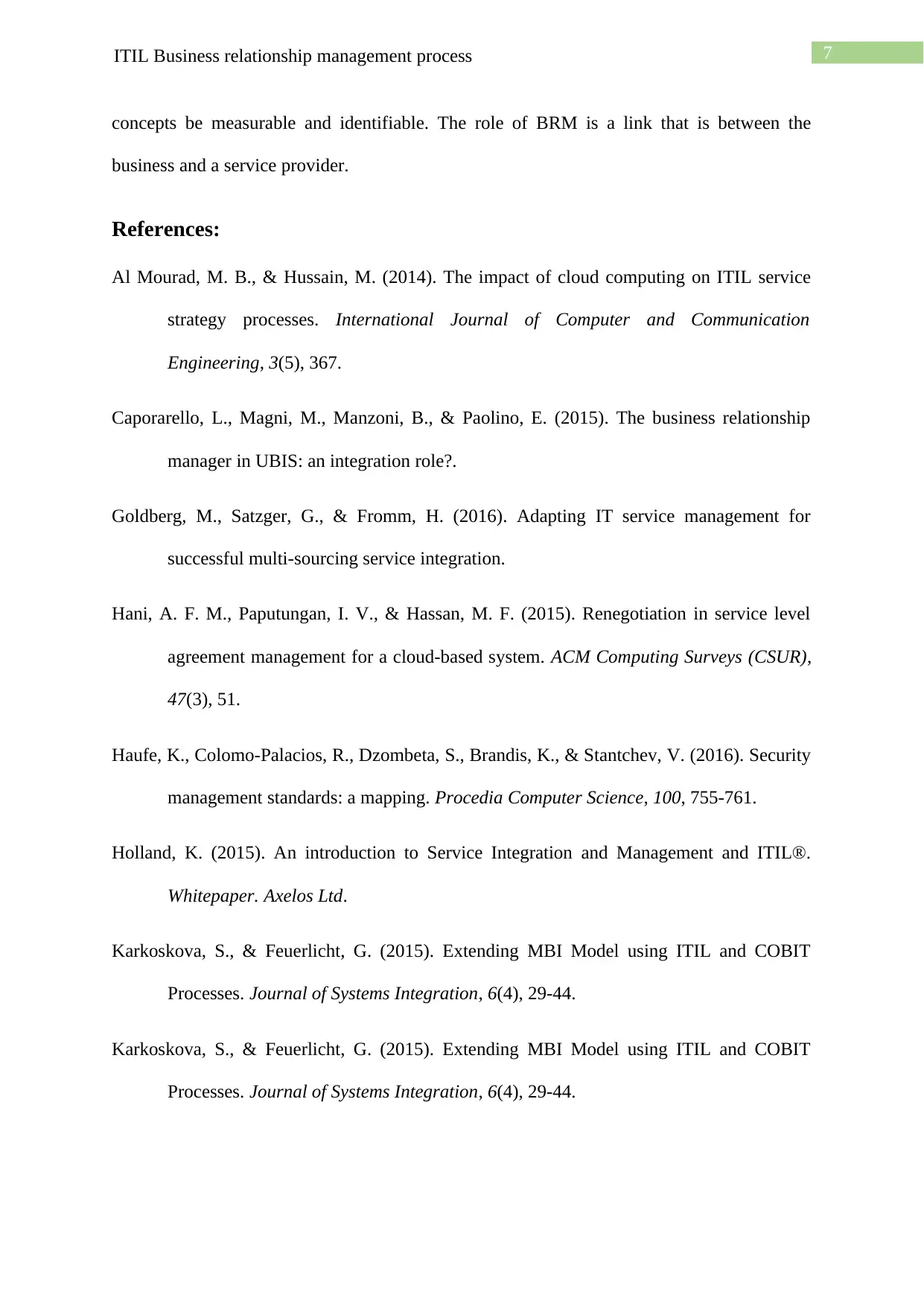
7ITIL Business relationship management process
concepts be measurable and identifiable. The role of BRM is a link that is between the
business and a service provider.
References:
Al Mourad, M. B., & Hussain, M. (2014). The impact of cloud computing on ITIL service
strategy processes. International Journal of Computer and Communication
Engineering, 3(5), 367.
Caporarello, L., Magni, M., Manzoni, B., & Paolino, E. (2015). The business relationship
manager in UBIS: an integration role?.
Goldberg, M., Satzger, G., & Fromm, H. (2016). Adapting IT service management for
successful multi-sourcing service integration.
Hani, A. F. M., Paputungan, I. V., & Hassan, M. F. (2015). Renegotiation in service level
agreement management for a cloud-based system. ACM Computing Surveys (CSUR),
47(3), 51.
Haufe, K., Colomo-Palacios, R., Dzombeta, S., Brandis, K., & Stantchev, V. (2016). Security
management standards: a mapping. Procedia Computer Science, 100, 755-761.
Holland, K. (2015). An introduction to Service Integration and Management and ITIL®.
Whitepaper. Axelos Ltd.
Karkoskova, S., & Feuerlicht, G. (2015). Extending MBI Model using ITIL and COBIT
Processes. Journal of Systems Integration, 6(4), 29-44.
Karkoskova, S., & Feuerlicht, G. (2015). Extending MBI Model using ITIL and COBIT
Processes. Journal of Systems Integration, 6(4), 29-44.
concepts be measurable and identifiable. The role of BRM is a link that is between the
business and a service provider.
References:
Al Mourad, M. B., & Hussain, M. (2014). The impact of cloud computing on ITIL service
strategy processes. International Journal of Computer and Communication
Engineering, 3(5), 367.
Caporarello, L., Magni, M., Manzoni, B., & Paolino, E. (2015). The business relationship
manager in UBIS: an integration role?.
Goldberg, M., Satzger, G., & Fromm, H. (2016). Adapting IT service management for
successful multi-sourcing service integration.
Hani, A. F. M., Paputungan, I. V., & Hassan, M. F. (2015). Renegotiation in service level
agreement management for a cloud-based system. ACM Computing Surveys (CSUR),
47(3), 51.
Haufe, K., Colomo-Palacios, R., Dzombeta, S., Brandis, K., & Stantchev, V. (2016). Security
management standards: a mapping. Procedia Computer Science, 100, 755-761.
Holland, K. (2015). An introduction to Service Integration and Management and ITIL®.
Whitepaper. Axelos Ltd.
Karkoskova, S., & Feuerlicht, G. (2015). Extending MBI Model using ITIL and COBIT
Processes. Journal of Systems Integration, 6(4), 29-44.
Karkoskova, S., & Feuerlicht, G. (2015). Extending MBI Model using ITIL and COBIT
Processes. Journal of Systems Integration, 6(4), 29-44.
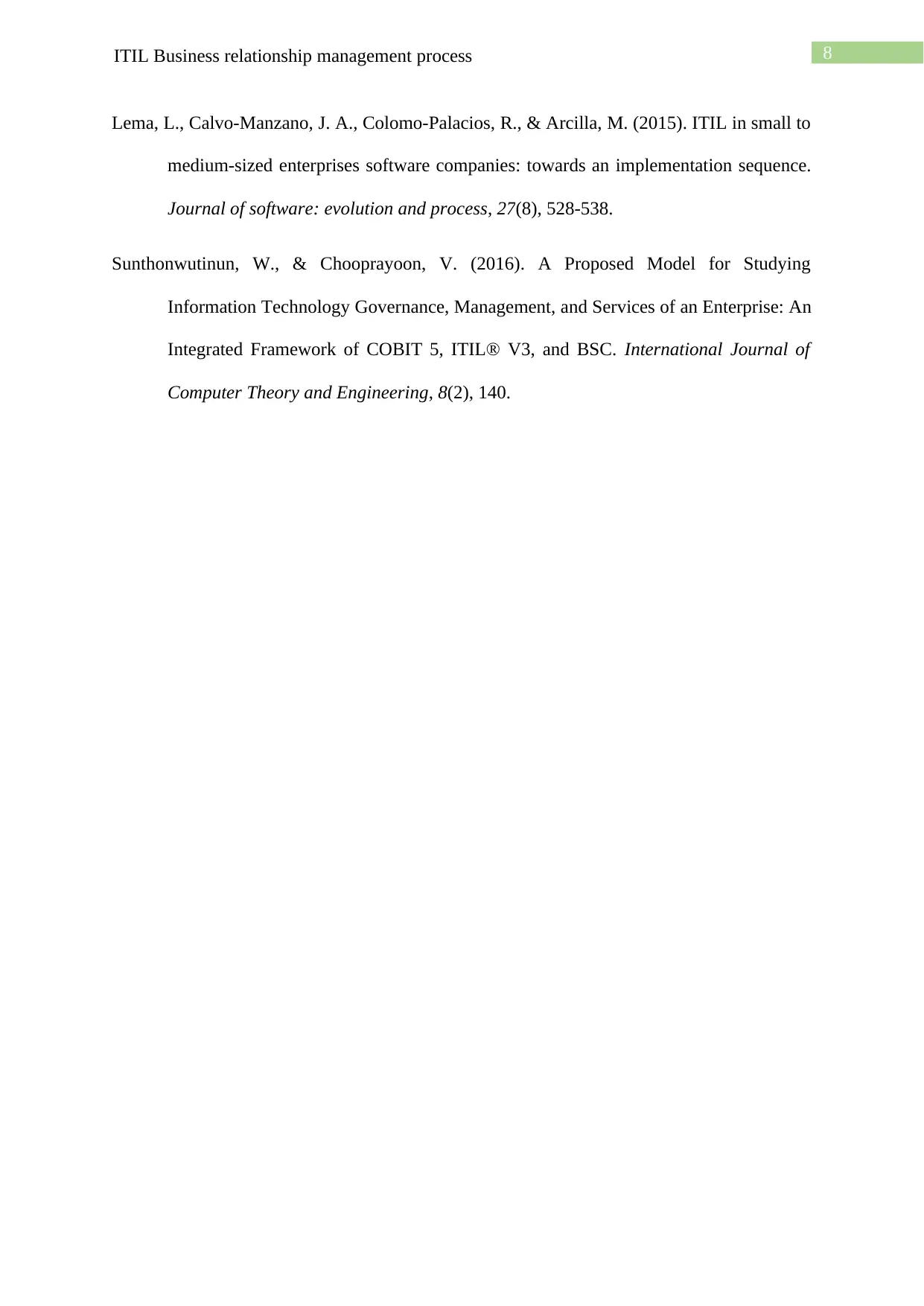
8ITIL Business relationship management process
Lema, L., Calvo‐Manzano, J. A., Colomo‐Palacios, R., & Arcilla, M. (2015). ITIL in small to
medium‐sized enterprises software companies: towards an implementation sequence.
Journal of software: evolution and process, 27(8), 528-538.
Sunthonwutinun, W., & Chooprayoon, V. (2016). A Proposed Model for Studying
Information Technology Governance, Management, and Services of an Enterprise: An
Integrated Framework of COBIT 5, ITIL® V3, and BSC. International Journal of
Computer Theory and Engineering, 8(2), 140.
Lema, L., Calvo‐Manzano, J. A., Colomo‐Palacios, R., & Arcilla, M. (2015). ITIL in small to
medium‐sized enterprises software companies: towards an implementation sequence.
Journal of software: evolution and process, 27(8), 528-538.
Sunthonwutinun, W., & Chooprayoon, V. (2016). A Proposed Model for Studying
Information Technology Governance, Management, and Services of an Enterprise: An
Integrated Framework of COBIT 5, ITIL® V3, and BSC. International Journal of
Computer Theory and Engineering, 8(2), 140.
⊘ This is a preview!⊘
Do you want full access?
Subscribe today to unlock all pages.

Trusted by 1+ million students worldwide
1 out of 9
Related Documents
Your All-in-One AI-Powered Toolkit for Academic Success.
+13062052269
info@desklib.com
Available 24*7 on WhatsApp / Email
![[object Object]](/_next/static/media/star-bottom.7253800d.svg)
Unlock your academic potential
Copyright © 2020–2025 A2Z Services. All Rights Reserved. Developed and managed by ZUCOL.





